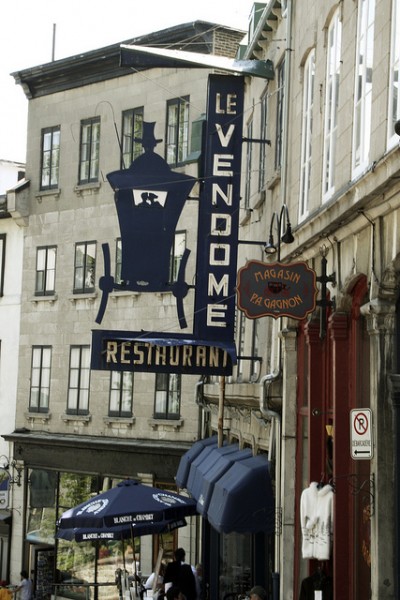En route from New York to Canada, we rehearsed simple French phrases like bonjour, au revoir, s’il vous plaît, and merci. And when we stopped for our first bathroom break in the province of Québec, Nick successfully asked, “Où se trouvent les toilettes?”
In fact, we were so engrossed in our French lessons that we missed our exit for Autoroute 20 east. You see, we didn’t have our GPS to reply upon because it lost service when we crossed the border. So I refocused my attention on my map reading responsibilities and soon we were cruising along in the correct direction past John Deeres plowing flat farm fields and strip malls with McDonalds and Ashley Meubles (Ashley Furnitures) and Home Depots.
After seven hours in the car, we were thankful to finally arrive in Old Quebec (which refers to the part of the city within the walls). We had just over 24 hours to explore before we headed back west to Montreal, so we dropped off our luggage in our (tiny, but comfortable) room in the Hotel Clarendon and headed along Rue Sainte-Anne towards the Lower Town.
The Lower Town is filled with streets and buildings dating back to the city’s 17th century beginnings. Samuel de Champlain founded Quebec City in 1608 and named it after the Algonquin word Kébec, meaning “where the river narrows” — in reference to the Saint Lawrence River.
The history of Quebec City is well preserved, and the neighborhood is vibrant and energetic and, at times, eclectic.
We walked the narrow cobblestone streets and wondered into art galleries and jewelry shops and clothing boutiques. And I furiously snapped photos of the unique French signs — both stylish and true to the history of the place.
And from every vantage point in the Lower Town, the most prominent feature in Quebec City is visible: the Château Frontenac. It opened in 1863 and is the most photographed hotel in the world (wikipedia) — thanks to plenty of help from us (more photos to come).
Next up: The crazy pig






It’s like I was just there! 🙂